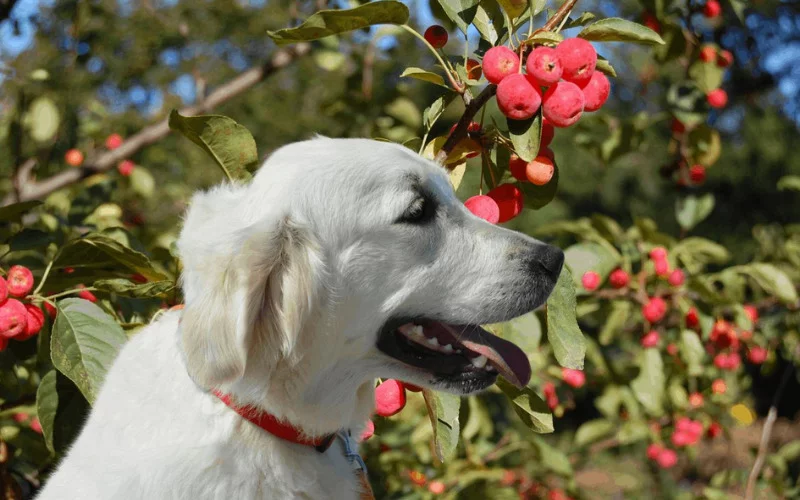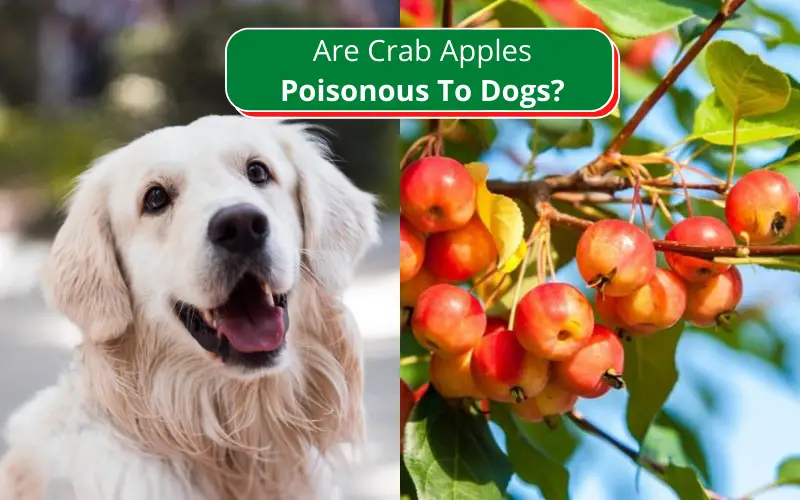Dogs are some of the most lovely pets to have around, they are smart, playful, and fun to have around; little wonder they are called: man’s best friend.
They eat lots of foods which they enjoy. Some of these foods might be delicious for you but not for your furry companion. One of such foods is an Apple.
Oh Yes, crab apples can hurt your dog because they are poisonous, especially if they eat the seeds and core, which contain the toxin cyanide that can cause a lot of stomach trouble or even death if consumed substantially.
So if you have a very nosy dog who always seems to be getting to places they out not to or eating things they see around, then you must be careful that they don’t ingest crab apple, which can hurt them.
Will Crab Apples Hurt My Dog?
Your dog is in danger of eating and getting poisoned by crab apple if you have a crab apple in your yard that can fall to the ground, and your dog rushes in and eats a couple of them without you knowing it.
If you don’t have a crab apple tree in your space and you don’t know how to tell them about other species of apple, then you are not alone; there are many people like you.
A crab apple is a small fruit shaped like an apple but has long stems, unlike a short apple. Its diameter can be anything from 1/4 to 2 inches. They look like cherries, changing their color from light green to a deep red as they ripen.
Crab apple trees can grow to a height of 15 to 30 feet tall, and the tree blooms in the spring to either white or bright Fuschia color.
Their oval leaves have a pointed end, and serrated edges are light green in spring, and they gradually turn a deeper green in summer, while in autumn, they can turn red, orange, red, or purple.
All apple trees, including crab apple trees, produce cyanogenic glycoside, a chemical compound converted to cyanide when eaten.
The amount of cyanogenic glycoside that crab apples contain is highly concentrated in the autumn when the fruit begins to ripen.
Are Crab Apples Poisonous To Dogs

Yes, and thousand times. Yes, crab apples are poisonous and can hurt your four-legged friend. This is because Amygdalin, a toxin produced by crab apple trees, is a type of cyanogenic glycoside that changes to cyanide when your dog consumes a whole crab apple, a d we all know that cyanide is lethal to dogs as well as humans.
When a dog eats crab apples, especially the seeds, stem, and core, the Amygdalin, which is now metabolized to cyanide, will cause digestive and cardiovascular problems for the dog, and if care is not administered promptly, it will trigger other systems of the dog body to fail which will eventually lead to come and in some cases death.
How to Know Your Dog Has Crab Apple Poisoning
If you notice some of the symptoms below in your, then the chances are that your dog is poisoned with cyanide from crab apple:
- Low blood oxygen levels
- Pulmonary congestion,
- Vomiting/ Nausea
- Loss of appetite
- Diarrhea
- Coma
- Tremors or shaking
- Seizures
- Brick red mucous membranes
- Dilated pupils
- Breathing difficulty
If your dog presents most of these symptoms, then contact a veterinarian or your local Animal Poison Control Center for prompt treatment; if not, the dog might suffer from long-term health issues like liver, heart, thyroid, and kidney problems,
How Do I Stop My Dog From Eating Crab Apple?
All dogs don’t like Crab apples because some of them are slightly bitter; however, if your dog loves the fruit, you have an issue in your hand, which is how to stop the dog from gaining access to the fruit. You can do the following to ensure you keep your pet and crab apples apart:
1. If you walk your dog along paths with crab apple trees, then tour the best option is to choose other crab apple-free paths.
If you must walk the dog through that path, you will have to go through the inconvenience of picking off fallen crab apples off the path you walk so that the dog can’t eat the apple behind your back. You must ensure that you don’t walk your dog off-leash to do this.
2. You could also train your dog to learn to listen when you command it to leave the crab apple. We must say this is a real chore, but it’s worth it anyway.
When you train the dog to simple key commands like “leave it,” “come,” and “drop it,” you will not only help keep your dog safe from crab apple poison, but you will have a dog that is better-behaved.
3. If you have crab apple trees in your yard, you must block off the area around the tree so that the dog can not gain access to the fruit or any part of the tree like the leaves because they are also poisonous.
If you can help it, you can cut down the crab apple tree in your yard to save yourself the stress of warding the dig off the tree. You can replace the tree with other trees that will not give you and your dog issues.
So, Can Dogs Eat Regular Apples?
You may be wondering if it is safe to feed your dog with regular apples seeing that crab apples can poison them. The answer is a resounding Yes; apples are good for dogs; in fact, the saying that “an apple a day keeps the doctor away” is also true for dogs.
Canine nutritionists believe that dogs eat apples regularly as a healthy change to their diet because apples have health benefits because they contain dietary fiber and vitamins.
Your dog can eat crab apple without being poisoned if you give the fruit to it in the right way. Firstly, you must be the crab apple properly to get rid of any pesticides and even germs left on it.
Secondly, you should ensure that you remove the stem, the core, and the seeds of the fruit before feeding it to the dog.
Watch the dog all through the day to see if it develops any stomach upset; it does, it is probably because you feed it more crab apples than is good for it.
You can go the extra mile of peeling off the back of the crab apple before feeding them to the dog. This is a great idea, especially if you are feeding a puppy with crab apple.
This is because the non-toxic skin of the crab apple is too sweet and has lots of fiber that it becomes too much for the dog, thereby leading to a stomach upset for the dog.
What Are The Benefits of crab apples for dogs?
Crab apple is a flavourful and crunchy fruit that is nutritious to both men and animals when consumed properly. They are fruits that contain antioxidants that both man and animals like dogs need because it helps protect the animals from free radicals, which are responsible for many heart and body ailments like cancer and heart diseases.
Like most fruits, crab apples are rich in vitamins A and C. They also contain minerals like phosphorus, calcium, and magnesium that your dog needs. They are rich in fiber which helps stop constipation in dogs. The cherry on the cake is that apple gives dogs a fresh breath
What Are Other Foods Dogs Should Not Eat?
Some foods are not good for your dogs because they will have similar effects as crab apples. Some of these foods might not hurt your dog Immediately, but they are not safe for them by and large. These forbidden foods include
- Anything that contains the Sweetener Xylitol.
- Foods that contain a high amount of Onions, Garlic, and Chives.
- Chocolate, Coffee, Caffeine, and foods that are made with these products
- Fruits like Grapes and Raisins.
- Meat, Eggs, and Bones that are raw or undercooked.
- Most nuts like Walnut and peanuts
- Salt, foods, and snacks that are too salty.
- All kinds of Alcoholic drinks and foods.
Conclusion
Not all dogs love crab apples, but if you are one of those whose dog has a taste for the fruit, you should ensure that you don’t allow the dog to eat the whole thing because the core seeds and stems of crab apples are poisonous to the canines.
If you notice some clinical signs like vomiting, diarrhea, nausea, and loss of appetite in your dog, you should quickly seek the help of a veterinarian because it might be the case of crab apple Poison.
Helpful Articles:
- Best Tetherball Set for Dogs
- Tetherball Game For Dogs
- Muddy Dog Yard Solutions
- What To Do With Backyard Dog Poop
We trust this article helped you know if you can have an alpaca in your backyard as a pet. You may also want to check out if you can have an Alpaca in your backyard as a pet.
Thanks for taking the time to read our article, and we hope you find it helpful. Would you mind leaving a comment below if you have any suggestions?
Kindly reach out to people by sharing this post on social media.
If you liked this article, then please follow us on Facebook, Instagram, and Pinterest.

